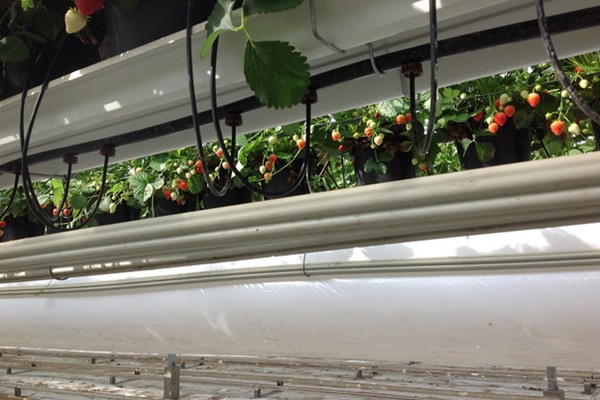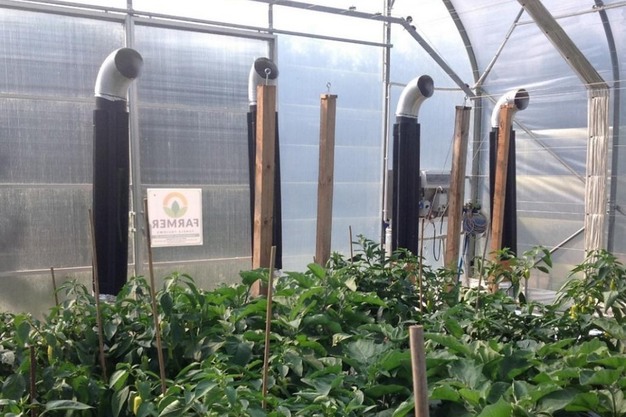Already a fixture in Polish greenhouses are star-shaped heating pipes, an innovation from Polish tomato and strawberry grower and inventor Andrzej Walczak. These pipes allow the grower to significantly save on energy costs, creating opportunities for application abroad, starting with the Netherlands, Belgium, and Germany. Why wouldn't these pipes, which also offer other technical advantages, fit well in greenhouses here too? That's the question posed by Dominik Swaczuk, who collaborates with the inventor.
Andrzej Walczak with his invention
Heating a greenhouse involves pumping water through pipes. Walczak constructs them with a diameter of 50 millimeters using pipes that originally measure 63 millimeters. After shaping them into a star, the diameter at the widest point of the star remains 50 millimeters. "But then only half as much water is needed inside. Consequently, less water needs to be heated, resulting in savings on energy costs," Dominik explains. "An additional advantage is that the system fills with water more quickly and cools down and warms up more rapidly several times a day."

Two variants of the patented star pipe have been developed: one can handle water temperatures up to 80 degrees, and the other can handle temperatures up to 60 degrees. This provides growers with options depending on their specific cultivation requirements.

Another advantage of the pipe, which has also been tested in Poland at the Agricultural University in Krakow, is its stiffness. It exceeds that of the current pipes used, meaning they bend less, especially compared to plastic pipes. This stiffness is also advantageous for handling increasingly advanced, and consequently heavier, pipe rail trolleys, as well as for recent advancements in robotics.

Dominik, endowed with pipes crafted through amicable connections, is keen to engage with prospective stakeholders. "While we currently meet demand adequately in Poland, we aspire to extend our reach to other markets too."

Star-shaped hoses
In addition to pipes, he also supplies star-shaped heating hoses in two varieties. The first is crafted from polypropylene, rendering the hose resistant to high temperatures, making it ideal as a growth tube between plants.
The second variant is a hose made of polyethylene, specifically designed for ground heat exchangers with glycol. Both hoses feature a star-shaped cross-section and have a diameter of 40 mm. They boast easy installation and necessitate no welding or painting.

Dehumidification and energy recovery system
The ground heat exchanger represents Walczak's latest innovation, recently patented, for a dehumidification and energy recovery system. Star-shaped polyethylene pipes, boasting a diameter of 250 mm, are employed for this purpose. "This system enjoys great popularity in Poland, particularly in residential construction." The interior of the pipes is coated with a layer resistant to mold and antibacterial properties.

"The core principle of the system," Dominik explains, "is to dehumidify the air." "A horizontal pipe, boasting high thermal conductivity, is buried in the greenhouse ground, reaching depths ranging between 40 and 200 centimeters. On one end, it ascends into a vertical channel above the ground surface, terminating with an air inlet, and below it, a fan is positioned. On the opposite end, it transitions into a vertical channel above the ground, eventually leading into a horizontal pipe connected to a film sleeve outfitted with air outlet openings."

The system achieves temperature stabilization and reduces air humidity, as evidenced by tests conducted at the agricultural university in Krakow. "During those tests, it demonstrated favorable plant growth and yield." The medium's temperature is set at the dew point temperature level for the pipe surface, utilizing data collected from ground temperature sensors, indoor air temperature sensors, and greenhouse humidity sensors.
Dominik also envisions opportunities for the technology employing pipes with a diameter of 250 millimeters in crops grown without heating. "The system can assist in mitigating light frost."
For more information:
Dominik Swaczuk
+31 650 579 183
dominikswaczuk@gmail.com
